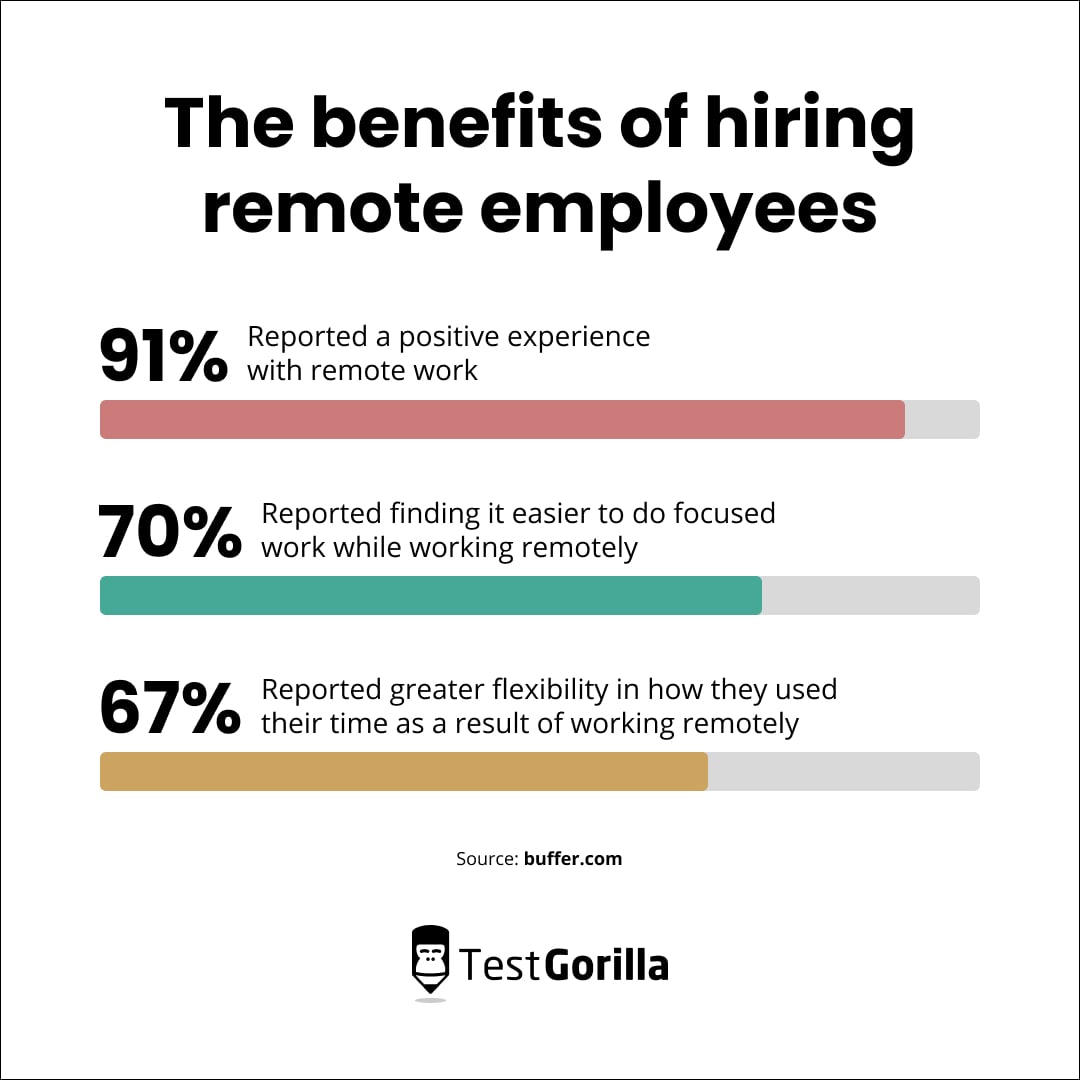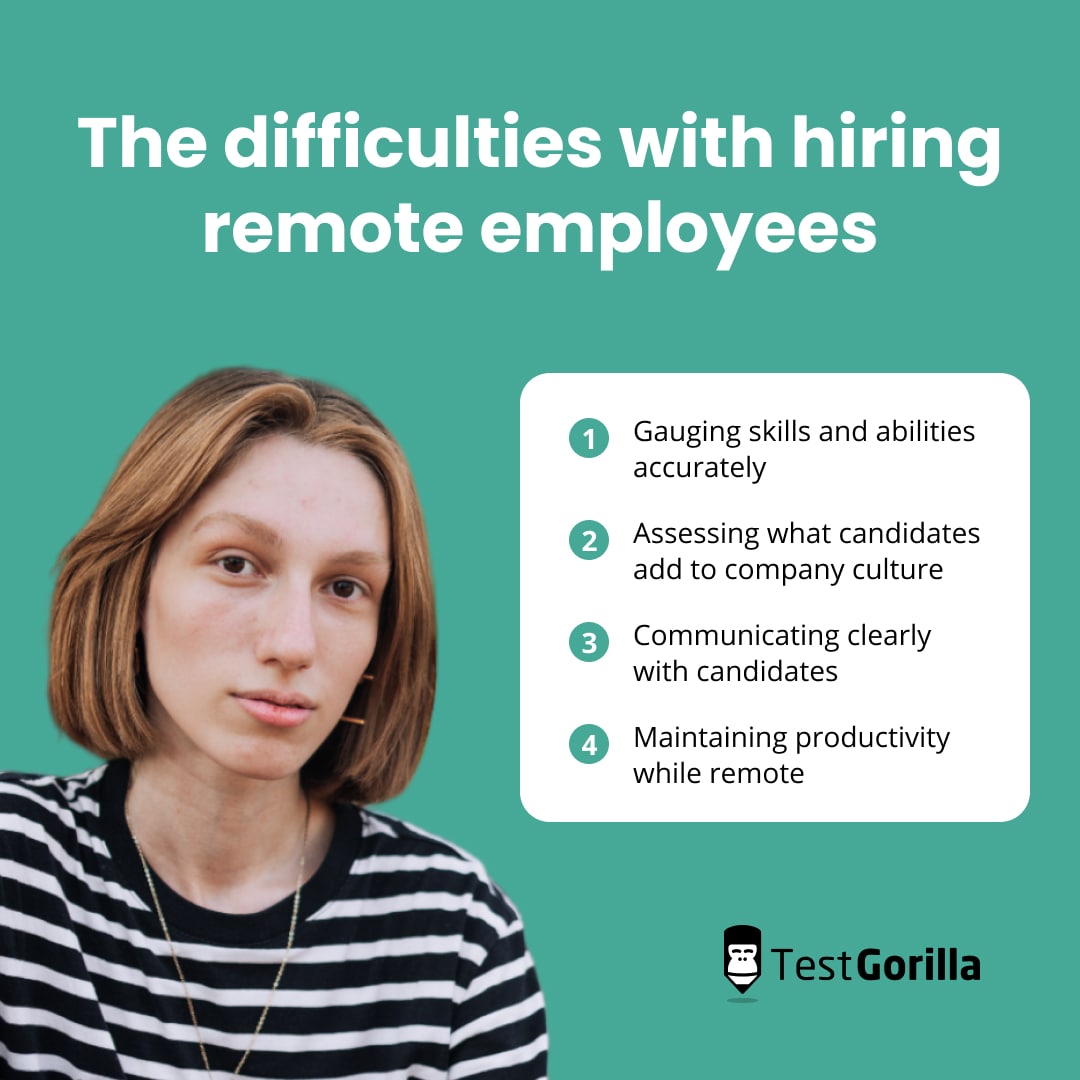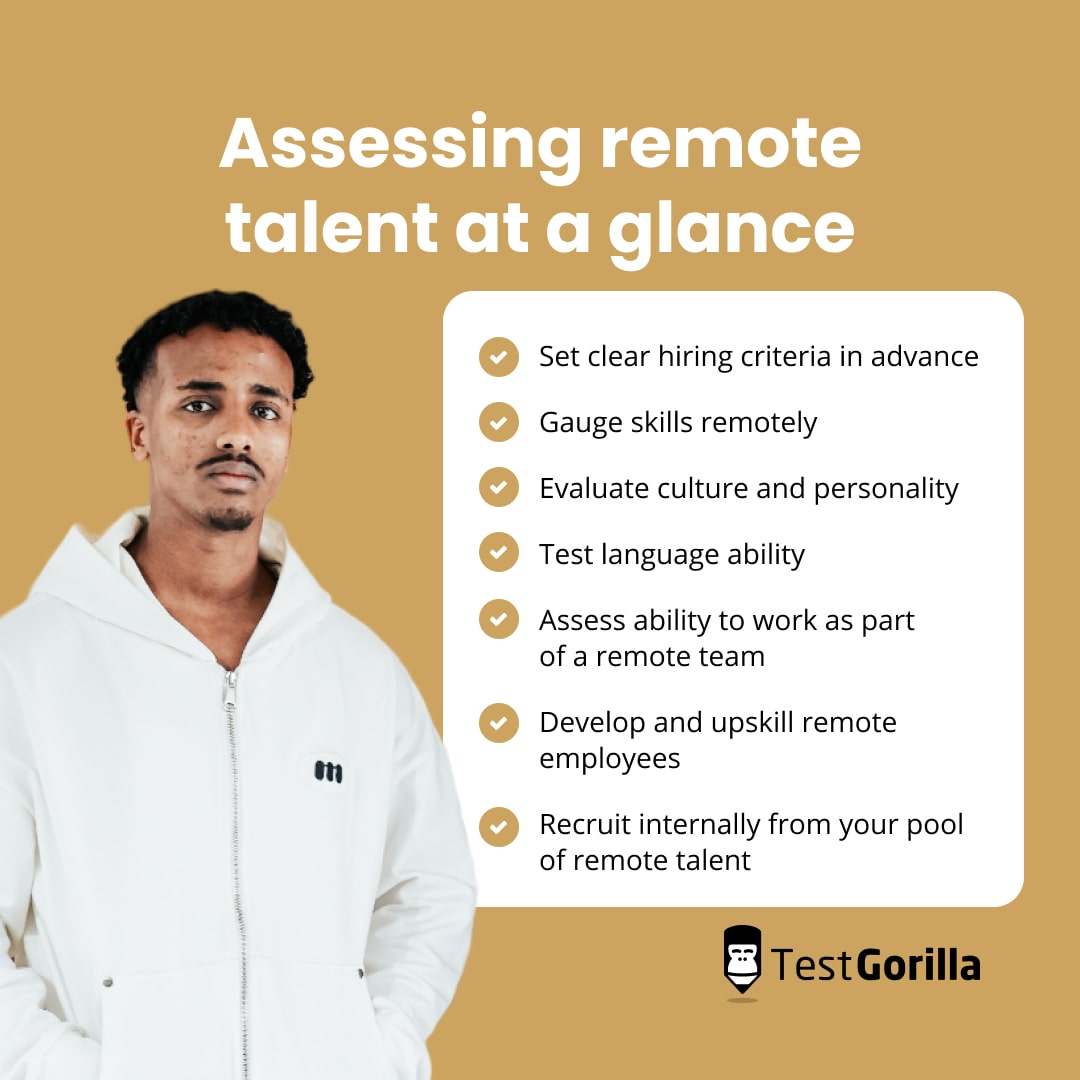Hiring remote employees: How talent assessments help you spot skill from miles away
In 2023, the global talent shortage reached a 17-year high, impacting an astonishing 77% of employers worldwide across the majority of industries.[1]
Many businesses are trying to fill these unprecedented skills gaps without being limited by geography.
By hiring remote employees, they reduce recruitment costs and expand the talent pool available to them. Plus, it’s a popular choice with many job seekers who value the opportunity to work with international companies.
However, remote and in-person hiring are different processes; not all employers are ready for this difference. They often struggle to accurately assess candidates’ skills and abilities without meeting them in person.
Enter talent assessments, the solution to remote hiring challenges.
This guide explores the benefits and difficulties of hiring remote employees before discussing helpful tips on how to use talent assessments to identify top talent worldwide.
Table of contents
- The benefits of hiring remote employees
- The difficulties with hiring remote employees
- How talent assessments help you hire remote employees
- 7 ways to use talent assessments to optimize hiring remote employees
- Beyond talent assessments: 4 best practices to remember for hiring remote employees
- Make hiring remote employees simple with skills testing
The benefits of hiring remote employees
Remote recruiting comes with serious benefits for employers and employees.
In Buffer’s State of Remote Work 2023 survey, 98% of respondents said they wanted to work remotely. And that’s not all:
91% reported a positive experience with remote work
67% reported greater flexibility in how they used their time as a result of working remotely
70% reported finding it easier to do focused work while working remotely
Employees appreciate the opportunity to work remotely. Offering them a benefit they appreciate improves morale, engagement, and retention among your workforce.
Organizations that hire remotely are also less limited by geography when recruiting. Access to a wider international talent pool enables companies to build a more diverse workforce, improving innovation.
Plus, when employees can work from anywhere, employers limit the overhead costs of opening and maintaining an office space.
Cost reduction is just a taste of the rewards businesses can reap by hiring remote employees.
To learn more about the benefits of remote recruiting, check out our in-depth guide.
The difficulties with hiring remote employees
The benefits of hiring remote workers are real – but so are the difficulties.
Companies that rely on traditional hiring methods struggle to make remote hiring work for them.
Traditional approaches to hiring assume that potential candidates and hiring managers meet in person, making assessing remote candidates challenging.
Here are the key differences that make remote hiring challenging for many businesses.
Gauging skills and abilities accurately
Even when you’re hiring in person, resume-based recruitment is highly unreliable.
Candidates could struggle to describe themselves fully on a resume – or they could choose to lie about their abilities outright.
Reading through detailed resumes (and trying to identify misrepresentation) takes up recruiters’ valuable time, slows the hiring process, and drives up hiring costs.
Those challenges get dramatically bigger when hiring remotely because conducting in-person tests or interviews to assess what candidates can do is impossible.
Assessing what candidates add to company culture
Hiring for culture add is vital. Getting a sense of a candidate’s personality and values is harder than ever when you don’t have the opportunity to meet them in person.
When interviewing candidates remotely, hiring managers struggle to gauge important qualities that indicate a candidate’s cultural contribution:
Personality
Body language
Soft skills
When interviewing remotely, it’s also harder for candidates to judge a company’s culture or understand its remote work policy.
This difficulty hinders both parties when deciding whether a candidate is right for a business – this issue is only worsened when companies are hiring for high volume positions, where remote interviews are conducted hastily in an effort to meet targets.
Communicating clearly with candidates
Candidates appreciate good communication when applying for on-site and remote jobs.
When surveyed, 19% of respondents said employers should focus on improving communication with candidates during the hiring process.
And if communication is challenging during in-person hiring, it’s even more difficult when recruiting remote workers.
Although online skills assessments and Zoom video calls work effectively, the necessary communication around those processes is sometimes a problem.
Language and time zone differences make communication a more effortful process during recruitment.
Maintaining productivity while remote
Work-from-home productivity is a skill in its own right, and many leaders are suspicious that their employees don’t have it.
A Microsoft survey shows that 85% of leaders aren’t confident that their employees are productive in a home work environment.
To make matters worse, companies that don’t use skills-based hiring methods often struggle to identify the skills that help employees work productively while remote.
Their inability to assess skills leads to costly mishires and damaged productivity in the long term.
How talent assessments help you hire remote employees
If you stick to traditional hiring methods when hiring remote employees, you’ll struggle to find the right people for your business. You risk:
Alienating candidates through poor communication
Misjudging candidates’ abilities and skills
Hiring candidates who won’t contribute to your company culture
Recruiting people who lack the skills to do productive remote work
Skills-based hiring methods, like talent assessments, help HR leaders address all these challenges and hire the best candidates.
In TestGorilla’s State of Skills-Based Hiring report, we found that:
81% of hybrid organizations use skills-based hiring methods
75% of fully remote companies use skills-based hiring methods
58% of businesses adopted skills-based hiring methods in the past two years
Skills-based hiring has boomed in response to the rise of remote work because it addresses many of the challenges of remote hiring. Using talent assessments gives businesses a clear and objective measure of candidates’ skills – including soft skills and culture add.
Talent assessments are also popular with candidates. More than 50% of candidates prefer a skills-first hiring process, including skills-based testing, over traditional hiring methods.
Workers value the opportunity to show what they can do without relying on their educational background or work experience.
Talent assessments are especially valuable for remote employees because their qualifications and experiences may not align with expectations in their employer’s home country.
When forced to rely on resume-based hiring, they may be unable to represent their abilities.
But with skills-based methods, they feel empowered to put themselves forward. That’s a difference employers notice.
A study by McKinsey reports that, after creating a skills-based job posting, one company went from one overqualified candidate to 18 candidates with all the necessary skills for the job.
Therefore, skills-based hiring broadens your talent pool and empowers you to hire for diversity remotely without any unconscious biases or culture differences getting in the way.
7 ways to use talent assessments to optimize hiring remote employees
Talent assessments are popular with employers and employees alike.
But to get the most out of skills-based hiring methods when hiring remote employees, you must ensure your business uses them smartly.
Asking candidates to perform talent assessments isn’t enough. You must measure the right skills and hire the right people for remote jobs.
Use these seven practical approaches to learn how to hire remote employees smartly using skills-based hiring.
Assessing remote talent at a glance
Using talent assessments | How it helps |
Set clear hiring criteria in advance | Improves hiring efficiency and ensures a fair, objective process |
Gauge skills remotely | Reduces reliance on resume-based hiring methods and enables candidates to show their abilities directly |
Evaluate culture and personality remotely | Empowers companies to hire for culture add and build a positive company culture |
Test language ability | Grants businesses access to a wider, more global pool of remote talent |
Assess ability to work as part of a remote team | Reduces the risk of hiring a worker who struggles with remote working skills |
Develop and upskill remote employees | Helps remote workers feel supported at work |
Recruit internally from your pool of remote talent | Encourages internal mobility within your organization |
1. Set clear hiring criteria in advance
One of the biggest benefits of skills-based hiring is its objectivity. It measures all candidates against the same benchmarks, empowering hiring managers to make more informed hiring decisions.
But if you don’t decide what those benchmarks are in advance, you risk introducing bias to the process. You also increase your chance of making a mishire, jeopardizing your business’s hiring efficiency.
You must decide which skills you want to measure before you start the hiring process.
Hiring managers and candidates know what to expect when you do, improving communication, which is vital when hiring remotely.
Use TestGorilla to build a custom skills assessment by following these easy steps:
Define the role you’re hiring for – for example, advertising copywriter
Select all the tests you want candidates to complete – for example, SEO Copywriting and PPC Advertising
Add any custom interview questions you want to ask candidates
Adjust any other relevant settings, such as anti-cheating features or candidate accommodations
2. Gauge skills remotely
Companies using traditional hiring methods rely on interviews and in-person tests to assess a candidate’s suitability for a job.
Hiring remote workers is a serious challenge – how can you gauge their skills if you can’t assess them in person?
TestGorilla has the fix: fully remote-friendly skills tests.
All of our tests can be completed from anywhere in the world as long as the candidate has a computer and an internet connection.
Employers invite candidates to take tests by sending a link via email. When they click the link, candidates see important information about the tests, including:
How many tests they need to complete
How long it takes to complete the tests
Information about anti-cheating measures and rules
Then, once the candidates have completed the assessments, hiring managers can see exactly how they did at each stage.
It’s easy to see each candidate’s strengths and weaknesses at a glance without needing to meet them face to face.
3. Evaluate culture and personality remotely
Assessing a candidate’s personality and culture add potential remotely is tough.
As we’ve discussed, it’s harder for employers to read cues like body language and tone via a remote video interview.
That’s why TestGorilla introduced the Culture Add test, designed to help hiring managers assess a candidate’s personality and values.
It shows what candidates have to offer your company culture and how well their beliefs align with your company’s mission.
TakeFortyTwo, a digital agency, discovered the benefits of the culture add test after realizing that its existing methods of assessing cultural fit weren’t working.
Its informal culture fit questionnaire didn’t reveal the necessary information about candidates’ values and beliefs.
After seizing the opportunity to overhaul its hiring methods and implement talent assessments, filtering out unsuitable candidates and hiring for culture add was much easier.
Plus, like all of our tests, the Culture Add test is remote-friendly.
4. Test language ability
Remote hiring means your talent pool extends to cover the whole world.
But most jobs still have specific language requirements – candidates need to show a certain level of proficiency in your company’s working language or in any languages needed for their role.
Businesses hiring remote workers need a manageable, remote-friendly way to assess language ability.
Fortunately, TestGorilla’s language tests are simple, accurate, and easy for candidates and employers.
The recognized Common European Framework of Reference for Languages is the basis for our tests. It holds candidates to a clear and objective standard of proficiency.
Revolut, a financial services firm, uses TestGorilla’s language tests to hire for its global, multi-lingual support teams.
Our language tests have reduced the firm’s time to hire by 30 to 40% and improved candidate quality and hiring efficiency.
5. Assess ability to work as part of a remote team
Remote work isn’t easy for every candidate. It’s an approach to work that demands a unique skill set, including:
Communication
Time management
The ability to follow instructions
Of course, those are important skills for in-person and hybrid candidates, too – but for remote positions, these skills could make the difference between a mishire and a successful recruitment process.
As we’ve explained, many employers don’t trust their remote workers to stay productive.
Businesses everywhere risk missing out on the cost savings and diversity benefits of remote work because they’re afraid their employees aren’t giving it their all.
TestGorilla solves that problem by making it easy for hiring managers to assess these vital work-from-home skills.
Our comprehensive test library contains assessments to gauge a candidate’s communication skills and ability to follow instructions and manage their time.
Use TestGorilla to combine all those tests into a single assessment that shows you how well-suited your candidates are to the demands of remote work.
6. Develop and upskill remote employees
The benefits of skills testing don’t end once you’ve recruited your remote workforce. Skill testing can be a powerful way to encourage internal mobility in your workplace.
Remote workers, especially in hybrid companies without a remote work culture, often feel left out of opportunities for training and development.
If companies don’t proactively try to make their upskilling opportunities remote-friendly, they risk excluding their remote teams.
Over time, that practice could lead to remote workers missing out on employee promotions and other career progress chances.
TestGorilla offers a simple fix to this problem: Use skills testing to perform a skills gap analysis, so you can identify each employee’s unique development and upskilling needs.
Asking all your current employees to take skills tests gives HR leaders a clear picture of which skills your organization has – and which ones it needs to develop.
After that, it’s easy to provide each employee, remote or in-person, with the training opportunities they need, setting them up for future success within your company.
7. Recruit internally from your pool of remote talent
Internal recruitment is great for companies. It’s cost-effective, efficient, and a great driver of internal mobility.
But even when hiring from your existing talent, you must ensure your candidates have the skills they need to thrive in more senior roles.
That’s challenging for remote teams because business managers may not have a direct, day-to-day sense of their workers’ soft skills, such as leadership or collaboration.
Those skills are crucial for employees hoping to advance into management roles.
TestGorilla’s test library includes the Leadership and People Management test, which assesses critical leadership skills such as:
Responsible delegation
Providing feedback to others
Supporting others’ development
This test offers hiring managers real insight into the abilities of internal remote candidates for management positions. If a candidate is successful, it’s a great measure of their ability to succeed as a leader.
If the test shows that a candidate’s leadership skills still need work, it’s an opportunity for their manager to develop their abilities further – perhaps using a leadership development plan.
Talent assessments also help companies identify high-potential employees (HiPos) and nurture their career progression, i.e., placing them on fast-track paths toward management or building their skill sets as future subject matter experts.
Beyond talent assessments: 4 best practices to remember for hiring remote employees
The process of hiring remote employees doesn’t end with skills testing.
You must take every possible measure to optimize your remote hiring process.
Everything counts when trying to attract top talent – from job descriptions to company culture. If your business isn’t prepared, skills-based hiring might not be enough to attract the best candidates.
Follow these actionable best practices on how to recruit remote employees to ensure every aspect of your company is ready for remote recruitment.
Best practices for hiring remote employees at a glance
Best practice | How it helps |
Write great job descriptions | Create clear and realistic expectations about the role for all parties, making the hiring process more efficient |
Use a range of online recruitment platforms | Access a wider talent pool of international employees, including candidates who specifically want to work remotely |
Use structured interviews alongside skills tests | Build a more rigorous, data-driven hiring process and reduce implicit bias when recruiting |
Work on building a remote-first culture | Develop a culture that supports remote workers in every aspect of their working life, increasing retention and engagement |
1. Write great job descriptions
A good job description should encourage candidates to apply. But writing a job description that attracts high-quality candidates is tougher than many recruiters think.
Many organizations don’t re-evaluate job descriptions between hires.
You should make your job descriptions as clear and focused as possible.
Avoid confusing language like “rockstar” or “genius,” and be specific about the role’s responsibilities to empower candidates to decide whether they’re the right fit for the job.
It’s also smart to be transparent about pay so expectations are clear and nobody gets an unpleasant surprise about proposed salaries late in the hiring process.
When hiring remote employees, recruiters must ensure job descriptions contain specific information that’s relevant to their target audience.
That includes:
Required time zone availability
Necessary language proficiency
Any equipment provided by the company (and any equipment candidates must provide)
Openness to hiring a contractor instead of a direct employee
2. Use a range of online recruitment platforms
Recruitment platforms like LinkedIn and Indeed are valuable tools for employers and candidates.
They enable recruiters to reach out to potential new hires directly, making it easy for applicants to find jobs that fit their skills, abilities, and experience.
But the big platforms aren’t the only ones – and if you aren’t posting your open positions more broadly, you could be missing out on amazing new hires.
That’s especially true if you’re looking to hire remote workers. Many people who want to work remotely use specialized job boards and websites to find employers willing to hire staff worldwide.
Ignoring those specialized recruitment platforms is a big mistake.
Posting your job descriptions as broadly as possible, including on social media, opens up a wider talent pool and improves your chances of finding the best candidate.
So, take the time to research remote-friendly job boards when recruiting – it could make the difference between hiring a good applicant and hiring a great one for your job opening.
3. Use structured interviews alongside skills tests
Skills-based hiring is a more rigorous approach to recruitment. It focuses on objective data about candidates’ skills and abilities, making it easier to reduce implicit bias in the hiring process.
But it’s still possible for bias to affect the interview process if your company doesn’t adopt a structured interview approach.
Research shows that recruiters make 25.5% of hiring decisions in the first 5 minutes of an interview.[2]
That isn’t enough time for hiring managers to make informed decisions – it’s a matter of bias and disadvantages candidates from underrepresented groups.
Structured interviews are an important step toward eliminating bias in hiring. A structured interview involves:
Sticking to a set of pre-established questions in the same order
Judging candidate answers based on clear criteria
Focusing on the core needs of the role through behavioral and situational questions
This approach makes comparing objective data about candidates easier, just like skills-based hiring methods.
4. Work on building a remote-first culture
Once you’ve hired remote workers, you must focus on retaining them.
If remote employees don’t feel acknowledged, supported, or included in your workplace, they’re much more likely to leave – meaning you need to hire new workers for their vacated role.
This is known as voluntary turnover, and it costs US businesses $1tn every year.[3]
Avoid the risk of alienating your remote team members by building a remote-first culture.
Take the following vital steps to engage your remote employees and give them the tools they need to succeed within your company:
Make employees’ responsibilities clear
Establish expectations around availability, taking time zones into account
Give workers ways to communicate quickly and easily
Stay connected with casual remote hangouts
Invest in in-person team-building meets once or twice a year
Implement ways of acknowledging and rewarding good performance
Offer resources and programs to support your team’s health and wellbeing
Old-fashioned approaches to developing company culture don’t work effectively when your staff is based remotely and enjoys flexible work.
Be intentional and proactive about building a company culture that spans the globe.
Make hiring remote employees simple with skills testing
Hiring remote employees comes with unique challenges. Organizations reliant on traditional hiring methods often struggle to gauge remote candidates’ abilities, personality, and aptitude for remote work.
But with skills-based hiring methods like talent assessments, hiring remote employees for your global team is more straightforward than ever.
It’s easy to create the skills tests you need to gauge the candidates’ quality and recruit the best talent wherever you find it.
With personality and culture tests like the Enneagram test, leaders can understand candidates’ ideals and motivations, reducing the risk of mishires and building a great company culture.
Want to learn more?
Learn how to use talent assessments to create new employee training and development opportunities and support your remote employees for the full length of their time with your company.
Or try our guide to the new employee onboarding process, and make sure your employees all over the world feel like they’re part of the same team.
Sources
“2023 Global Talent Shortage”. (2023). ManpowerGroup. Retrieved July 26, 2023. https://go.manpowergroup.com/hubfs/MPG_TS_2023_Infographic_FINAL.pdf
Nisen, Max. (May 19, 2015). “Here’s how quickly interviewers decide whether or not to hire you”. Quartz. Retrieved July 18, 2023. https://qz.com/406976/heres-how-quickly-interviewers-decide-whether-or-not-to-hire-you
McFeely, Shane; Wigert, Ben. (March 13, 2019). “This Fixable Problem Costs U.S. Businesses $1 Trillion”. Gallup. Retrieved July 18, 2023. https://www.gallup.com/workplace/247391/fixable-problem-costs-businesses-trillion.aspx
Related posts
You've scrolled this far
Why not try TestGorilla for free, and see what happens when you put skills first.
Latest posts
The best advice on pre-employment testing, in your inbox.
No spam. Unsubscribe at any time.

Hire the best. No bias. No stress.
Our screening tests identify the best candidates and make your hiring decisions faster, easier, and bias-free.
Free resources
This checklist covers key features you should look for when choosing a skills testing platform
This resource will help you develop an onboarding checklist for new hires.
How to assess your candidates' attention to detail.
Learn how to get human resources certified through HRCI or SHRM.
Learn how you can improve the level of talent at your company.
Learn how CapitalT reduced hiring bias with online skills assessments.
Learn how to make the resume process more efficient and more effective.
Improve your hiring strategy with these 7 critical recruitment metrics.
Learn how Sukhi decreased time spent reviewing resumes by 83%!
Hire more efficiently with these hacks that 99% of recruiters aren't using.
Make a business case for diversity and inclusion initiatives with this data.




















